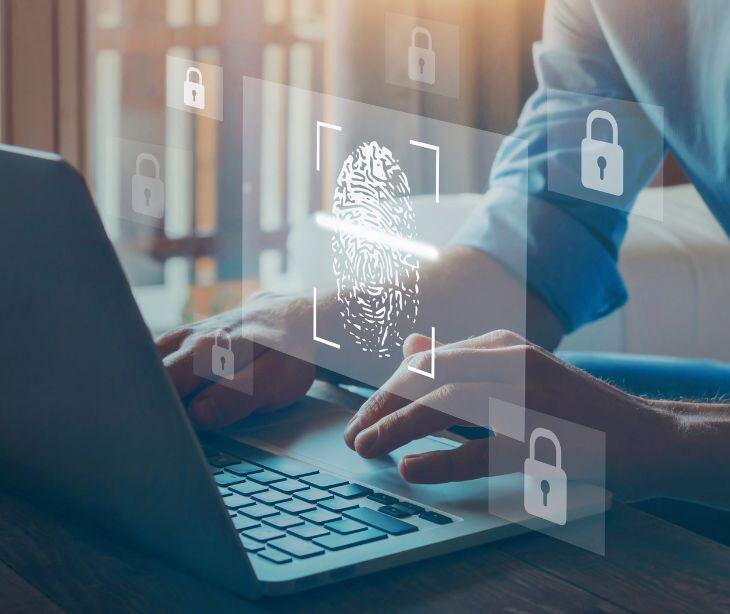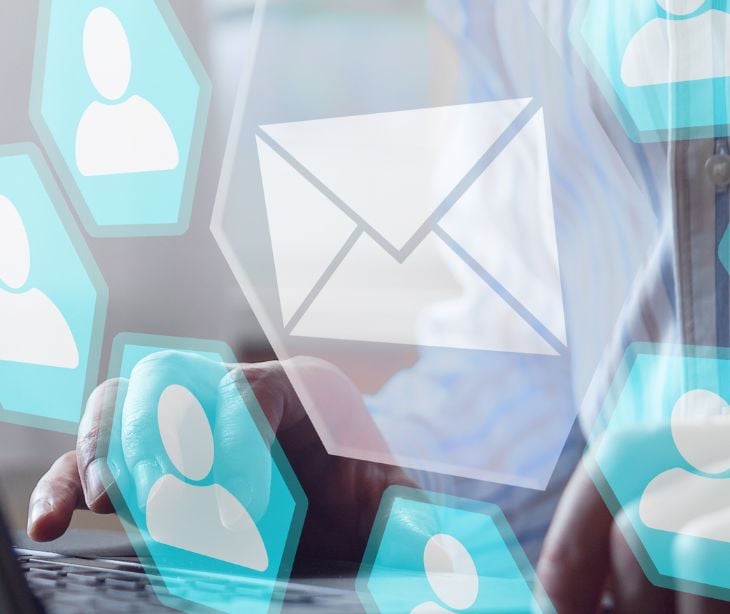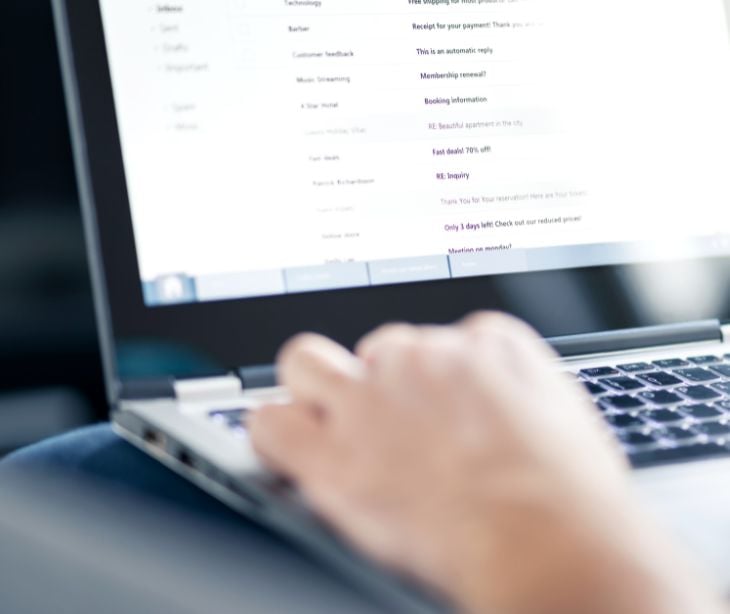
Email authentication verifies the sender's identity before a message is delivered to the recipient's inbox. This is beneficial in combating the growing problem of email spoofing, where malicious actors impersonate legitimate senders to trick unsuspecting recipients into divulging sensitive information or engaging with harmful content. Spoofing remains one of the most common forms of online attack, with 3.1 billion domain spoofing emails delivered per day.
Understanding email authentication
The email authentication process involves a series of handshakes between the sending and receiving mail servers, where the latter consults various DNS records to validate the sender's authenticity. By implementing these protocols, mailbox providers can differentiate between legitimate senders and those attempting to exploit the trust of their users, ultimately safeguarding the integrity of the email ecosystem.
The pillars of email authentication
SPF
The Sender Policy Framework (SPF) is a foundational email authentication protocol that establishes a list of authorized IP addresses or hostnames that are permitted to send emails on behalf of a specific domain. When a receiving mail server encounters an email, it checks the SPF record in the domain's DNS to ensure the message is originating from an approved source. This helps mitigate the risk of email spoofing by preventing unauthorized parties from impersonating a legitimate sender.
DKIM
DomainKeys Identified Mail (DKIM) is another email authentication protocol that uses a combination of public and private keys to verify the identity of the sender. When an email is sent, a digital signature is added to the message header, which the receiving mail server can then use to authenticate the message's origin. Unlike SPF, DKIM remains effective even when an email is forwarded, making it an advanced solution for securing the email communication chain.
DMARC
Domain-based Message Authentication, Reporting, and Conformance (DMARC) is a policy-based protocol that builds upon the foundations of SPF and DKIM. DMARC provides a framework for senders to specify how receiving mail servers should handle messages that fail authentication, offering options to quarantine or reject such emails. Additionally, DMARC generates valuable reports that give senders insights into their email traffic, allowing them to identify and address any potential issues with their authentication methods.
BIMI
Brand Indicators for Message Identification (BIMI) is the latest addition to the email authentication ecosystem, serving as a visual cue for recipients to identify trusted senders. When implemented correctly, BIMI displays a verified, trademarked logo next to the sender's name in the recipient's inbox, further enhancing the trustworthiness of the message and the brand it represents. However, BIMI is contingent on the successful implementation of DMARC, making it a complementary component of the overall email authentication strategy.
The importance of email authentication
As we move into 2024, the email authentication field is undergoing a major shift. Gmail and Yahoo, two of the largest mailbox providers, have announced new requirements for bulk senders, making the adoption of email authentication protocols a mandatory step for maintaining deliverability and reaching their users' inboxes.
These new guidelines stipulate that all bulk senders must implement SPF, DKIM, and DMARC – a move that aims to combat the persistent issues of email spoofing and spam. While these requirements may initially seem daunting, they represent a necessary step in safeguarding the email ecosystem and preserving the trust between brands and their customers.
Navigating the new sender requirements
The impending changes in 2024 mean that senders must take proactive steps to ensure their email authentication protocols are properly configured and functioning regardless of their email volume. Failure to do so could result in their messages being intercepted, relegated to the spam folder, or even completely rejected by the major mailbox providers.
One of the challenges facing senders is the complexity of setting up and maintaining these authentication methods. From configuring SPF records to managing DKIM keys and implementing a DMARC policy, the technical aspects can be daunting, especially for those without a strong IT or cybersecurity background.
However, the benefits of getting it right far outweigh the initial investment of time and effort. By embracing email authentication, senders can not only meet the new requirements but also enhance the deliverability and trustworthiness of their email communications, ultimately strengthening their brand's reputation and fostering deeper connections with their audience.
Implementing email authentication protocols
Setting up SPF
SPF is the first step in the email authentication process. To implement SPF, senders must create a DNS TXT record that specifies the authorized IP addresses or hostnames permitted to send emails on behalf of their domain. Receiving mail servers then reference this record to verify the sender's legitimacy.
Configuring SPF can be straightforward, especially if your email service provider handles it automatically. However, for senders with a more complex email infrastructure or those using a dedicated IP address, the setup may require more attention to detail. To avoid potential deliverability issues, it's necessary to ensure that the SPF record accurately reflects all the authorized sources of your email traffic.
Implementing DKIM
DKIM is the next layer of email authentication, providing an additional level of security through the use of digital signatures. To set up DKIM, senders must generate a public-private key pair and publish the public key in their domain's DNS records.
The private key is then used to create a unique digital signature that is appended to the email header, allowing receiving mail servers to verify the message's origin. Unlike SPF, DKIM remains effective even when an email is forwarded, making it a fundamental component of a detailed email authentication strategy.
Configuring DMARC
DMARC is the final piece of the email authentication puzzle, serving as a policy that ties together the SPF and DKIM protocols. By publishing a DMARC record in the domain's DNS, senders can specify how receiving mail servers should handle messages that fail authentication, as well as request valuable reports on their email traffic.
The DMARC policy offers three main options: "none," "quarantine," and "reject." While a "none" policy may be acceptable as an initial step, the long-term goal should be to implement a more stringent "quarantine" or "reject" policy, effectively preventing unauthorized messages from reaching the inbox and protecting both the sender's brand and their customers.
Enabling BIMI
BIMI is the newest addition to the email authentication ecosystem. It provides a visual cue to recipients that the message they're about to open is from a trusted and verified source. To enable BIMI, senders must have a properly configured DMARC policy in place and a trademarked logo that meets the BIMI specification requirements.
While BIMI is not yet a mandatory requirement, its adoption can provide a boost to brand recognition and user trust. By displaying the sender's logo in the recipient's inbox, BIMI reinforces the message's authenticity and helps to differentiate the sender from potential impersonators.
Go deeper:
The benefits of email authentication
Implementing an email authentication strategy offers a multitude of benefits for senders:
Protecting customers and subscribers
By implementing email authentication protocols, senders can effectively combat the scourge of email spoofing, preventing malicious actors from impersonating their brand and tricking customers into divulging sensitive information or engaging with harmful content. This not only safeguards the recipient but also preserves the trust and goodwill that the sender has worked hard to cultivate.
Protecting brand reputation
In an era where cybersecurity threats are a constant concern, brands that can demonstrate a commitment to email authentication and security are more likely to be trusted by their customers. By stopping phishing attempts and other forms of email fraud, senders can maintain the integrity of their brand and avoid the reputational damage that can result from successful spoofing incidents.
Enhancing email deliverability
Email authentication protocols play a part in supporting email deliverability. When mailbox providers can confidently verify the identity of the sender, they are more likely to accept and deliver the message to the recipient's inbox. Conversely, a failure to implement these protocols can increase the risk of legitimate emails being flagged as spam or rejected altogether, negatively impacting the sender's overall email performance.
In the news
Google and Yahoo have announced new requirements for sending more than 5,000 messages daily to Gmail and Yahoo addresses, respectively. Effective February 1, 2024, these standards will mandate domain authentication.
While most email marketing senders have already set up SPF records and DKIM, larger senders will now need to fully align DMARC with both SPF and DKIM to ensure authentication.
These changes are part of Google and Yahoo's efforts to combat phishing, spam, and malware transmitted through email.
Google has stated, "Bulk senders who don't meet the sender requirements will start receiving temporary errors (with error codes) on a small percentage of their non-compliant email traffic." By April 2024, the rate of rejected non-compliant emails will increase, and by June 2024, large senders must meet all requirements to ensure continued delivery.
Read more: How to comply with Google's new email sender guidelines
How Paubox can help
DMARC rounds up the currently available methods for email authentication, along with DKIM and SPF. The good news is that Paubox Email Suite Plus can perform all three as part of the hundreds of checks it makes against incoming emails. But we know how fast spammers’ tactics change, so your inbox can never be too safe. As previously mentioned in other posts, there are ways to get around to DKIM and SPF, which makes it possible to bypass DMARC, too. For added protection, your inbox needs the advanced threat detection features Paubox Email Suite Plus offers, like ExecProtect, which stops display name spoofing attacks from reaching users. You can see ExecProtect in action for yourself with a free 14-day trial.
Learn more: HIPAA Compliant Email: The Definitive Guide
FAQs
What are email authentication protocols, and why are they important in healthcare?
Email authentication protocols are technologies designed to prevent email spoofing and phishing. In healthcare, these protocols are beneficial as they help to protect sensitive patient information, maintain the integrity of communication, and ensure compliance with regulations like HIPAA. By verifying the sender's identity, these protocols reduce the risk of unauthorized access to confidential data.
How does SPF work to protect healthcare email communications?
SPF works by allowing domain owners to specify which mail servers are permitted to send emails on their behalf. When an email is received, the recipient's mail server checks the SPF record of the sending domain to verify that the email is from an authorized server. In healthcare, this helps prevent phishing attacks where malicious actors attempt to impersonate trusted entities, thereby safeguarding sensitive patient data and maintaining trust in communications.
What is the role of DKIM in securing healthcare emails?
DKIM adds a digital signature to the email's header, which can be verified by the recipient's mail server using the sender's public key published in the DNS records. This signature ensures that the email has not been tampered with during transit and confirms the sender's identity. In healthcare, DKIM helps maintain the integrity and authenticity of email communications, ensuring that sensitive information remains confidential and unaltered.
Can DMARC help prevent email spoofing in healthcare organizations?
Yes, DMARC helps prevent email spoofing by providing a mechanism for email domain owners to publish policies on how to handle emails that fail SPF or DKIM checks. It allows organizations to specify whether such emails should be quarantined or rejected. For healthcare organizations, implementing DMARC reduces the likelihood of fraudulent emails reaching staff or patients, thereby enhancing email security and protecting sensitive health information from phishing attacks.
Subscribe to Paubox Weekly
Every Friday we'll bring you the most important news from Paubox. Our aim is to make you smarter, faster.



